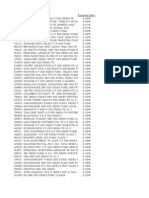Lecture2
Uploaded by
Mami LalitaLecture2
Uploaded by
Mami LalitaLecture #2.
NATIONAL INCOME ACCOUNTING / GROSS NATIONAL
PRODUCT
Definitions
Gross National Product (GNP) – measures the value of goods and services
produced within a country's borders, by citizens and non-citizens alike. GNP
measures the value of goods and services produced by only a country's
citizens but both domestically and abroad (
https://www.investopedia.com. December 9, 2021).
Gross National Product (GNP) measures the market value of all final goods
and services produced by a nation’s economic resources during a specified
period. It reflects the economic performance of a nation (Silon, et al, 2010).
Gross domestic product (GDP) - is the monetary value of all finished goods
and services made within a country during a specific period. GDP provides
an economic snapshot of a country, used to estimate the size of an economy
and growth rate. GDP can be calculated in three ways, using expenditures,
production, or incomes (
https://www.investopedia.com. December 9, 2021).
GDP is the total market value of all final goods and services produced within
the territories of a nation in a given year. An increasing GDP suggests an
improving economy. However, it should be noted that in most third world
countries whose economy is dominated by foreigners, GDP is usually bigger.
This does not necessarily mean an improving economy. It may only mean
that the value of final goods and services produced by the foreigners in
these third world countries is increasing (Silon, et al, 2010).
Consumer Price Index (CPI) - is the instrument to measure inflation. It is
used to estimate the average variation between two given periods in the
prices of products consumed by households. It is a composite measurement
of trends in the prices of products, at constant quality (
https://www.investopedia.com. December 9, 2021).
A price index is a device for combining movements of many individual prices
for the purpose of estimating the average movement of some specified
group of prices. It is often used to deflate variables expressed in money
terms to take out the effect of price changes (Silon, et al, 2010).
Formulas
Remember: GNP =GNE = GNY = GNVA
1. Expenditure Approach (Gross National Expenditures or GNE)
GNP = GNE = C + I + G + (X – M) + NFIA
Where: C – Household Consumption (Cr or Co)
Cr – Real consumption
Co – Autonomous consumption
I – Gross domestic investment
I = RIC + DCE + Inv D
RIC – Residential and Industrial construction
DCE – Durable capital equipment
Inv D - Changes in inventory
G – Government expenditure
NI = I – CCA
NI – Net of Investment
CCA – Capital Consumption Allowance or Depreciation
X – Exports
M – Imports
NFIA = Xy – Me
NFIA – Net factor income from abroad
Xy – Export income (OFW and Filipino businesses’ income abroad)
Me – Import expenditures (foreigners’ income in the Philippines)
2. Income Approach (Gross National Income or GNY)
GNP = GNY = PY + GY + CP + IBT + CCA
Where: PY = w + r + i
PY – Personal income
w – wages or salary income
r – rent income
i – interest income
GY - Government income: Taxes and Non-tax income
CP – Corporate profits
IBT – Indirect business taxes, like VAT
CCA – Capital consumption allowance or Depreciation
3. Value Added Approach (Gross National Value Added or GNVA)
GNP = GNVA = VAA + VAI + VAS + NFIA
VAA – Value added by agricultural sector
VAI – Value added by industrial sector
VAS – Value added by service sector
Other Concepts:
GDP = GNP – NFIA
NY = GNP – IBT – CCA or NY = PY + CP + GY
PDY = PY - PYT
NY – National income
PDY – Personal disposable income
Examples:
#1) Given:
X = 1,000 DCE = 200 VAA = 1,000 Xy = 900
C = 400 w = 600 CCA = 200 RIC = 200 VAS = 400
VAI = 700 r = 300 IBT = 400 i = 200
Me = 600
CP = 500 G = 800 M = 600 Inv D = 100GY = 200
Compute:
a. GNE b. GNY c. GNVA d. GDP
You might also like
- Chapter 2 National income accounting (3)No ratings yetChapter 2 National income accounting (3)93 pages
- Macroecononomic National Income Accounting FINALxxNo ratings yetMacroecononomic National Income Accounting FINALxx20 pages
- National Income Accounts: Mrs. Sarah Alviar-Eisma Economics TeacherNo ratings yetNational Income Accounts: Mrs. Sarah Alviar-Eisma Economics Teacher16 pages
- RB CAGMAT REVIEW LEA Review - Macroeconomics - International TradeNo ratings yetRB CAGMAT REVIEW LEA Review - Macroeconomics - International Trade99 pages
- Chapter 3 - 23732465 - 2024 - 10 - 18 - 22 - 14No ratings yetChapter 3 - 23732465 - 2024 - 10 - 18 - 22 - 1415 pages
- Chapter 1: Basic Concepts National Income and Input: Gross Domestic ProductNo ratings yetChapter 1: Basic Concepts National Income and Input: Gross Domestic Product21 pages
- Edev 311: Economic Development: Session 2: Measuring The National Income Accounts and Cost of LivingNo ratings yetEdev 311: Economic Development: Session 2: Measuring The National Income Accounts and Cost of Living34 pages
- What Is 'Gross National Product - GNP': Personal Consumption Expenditures Investment Net ExportsNo ratings yetWhat Is 'Gross National Product - GNP': Personal Consumption Expenditures Investment Net Exports3 pages
- Fundamental Concepts of Macroeconomics NotesNo ratings yetFundamental Concepts of Macroeconomics Notes19 pages
- Nationalincome 141209072252 Conversion Gate02No ratings yetNationalincome 141209072252 Conversion Gate0237 pages
- National Income: Presented by Asst - Prof Nimbolkar V.R. MBA Finance (SET)No ratings yetNational Income: Presented by Asst - Prof Nimbolkar V.R. MBA Finance (SET)18 pages
- Measuring of National Income: The Output ApproachNo ratings yetMeasuring of National Income: The Output Approach3 pages
- Disrupted Economic Relationships: Disasters, Sanctions, DissolutionsFrom EverandDisrupted Economic Relationships: Disasters, Sanctions, DissolutionsTibor BesedesNo ratings yet
- Measurement of Macroeconomic AggregatesNo ratings yetMeasurement of Macroeconomic Aggregates10 pages
- Canadian Provinces and Territories by GDPNo ratings yetCanadian Provinces and Territories by GDP9 pages
- JBP 2023 - The Role of Economic Intelligence in Accelerating Welfare of Gorontalo ProvinceNo ratings yetJBP 2023 - The Role of Economic Intelligence in Accelerating Welfare of Gorontalo Province14 pages
- Macroeconomic Nowcasting and Forecasting With Big Data: Annual Review of EconomicsNo ratings yetMacroeconomic Nowcasting and Forecasting With Big Data: Annual Review of Economics32 pages
- Office of The Economic Adviser: Wholesale Price Index (WPI)No ratings yetOffice of The Economic Adviser: Wholesale Price Index (WPI)4 pages
- P Data Extract From World Development IndicatorsNo ratings yetP Data Extract From World Development Indicators78 pages
- Indexes of The World: Index Value Change % Change TimeNo ratings yetIndexes of The World: Index Value Change % Change Time21 pages

























































































